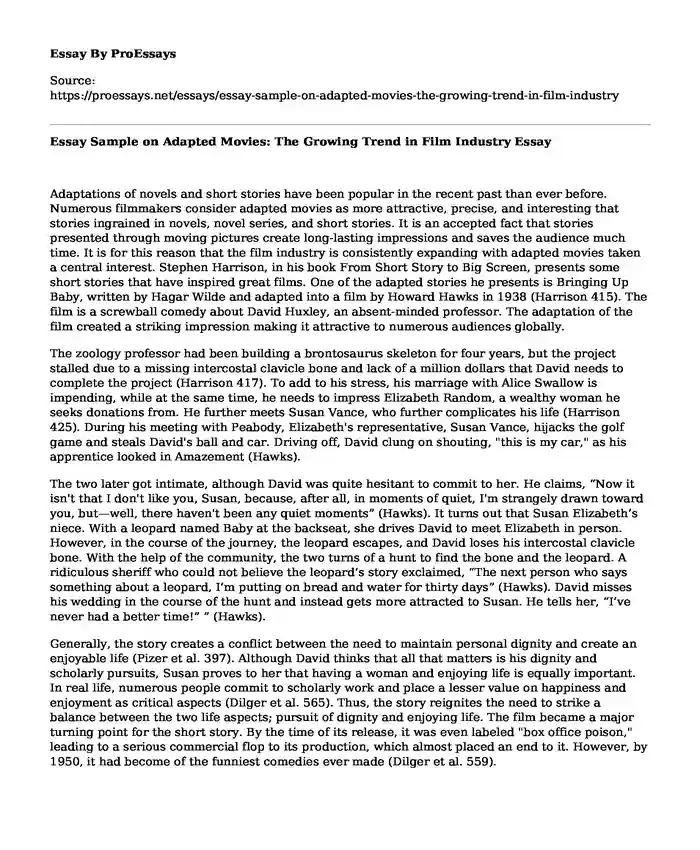Adaptations of novels and short stories have been popular in the recent past than ever before. Numerous filmmakers consider adapted movies as more attractive, precise, and interesting that stories ingrained in novels, novel series, and short stories. It is an accepted fact that stories presented through moving pictures create long-lasting impressions and saves the audience much time. It is for this reason that the film industry is consistently expanding with adapted movies taken a central interest. Stephen Harrison, in his book From Short Story to Big Screen, presents some short stories that have inspired great films. One of the adapted stories he presents is Bringing Up Baby, written by Hagar Wilde and adapted into a film by Howard Hawks in 1938 (Harrison 415). The film is a screwball comedy about David Huxley, an absent-minded professor. The adaptation of the film created a striking impression making it attractive to numerous audiences globally.
The zoology professor had been building a brontosaurus skeleton for four years, but the project stalled due to a missing intercostal clavicle bone and lack of a million dollars that David needs to complete the project (Harrison 417). To add to his stress, his marriage with Alice Swallow is impending, while at the same time, he needs to impress Elizabeth Random, a wealthy woman he seeks donations from. He further meets Susan Vance, who further complicates his life (Harrison 425). During his meeting with Peabody, Elizabeth's representative, Susan Vance, hijacks the golf game and steals David's ball and car. Driving off, David clung on shouting, "this is my car," as his apprentice looked in Amazement (Hawks).
The two later got intimate, although David was quite hesitant to commit to her. He claims, “Now it isn't that I don't like you, Susan, because, after all, in moments of quiet, I'm strangely drawn toward you, but—well, there haven't been any quiet moments” (Hawks). It turns out that Susan Elizabeth’s niece. With a leopard named Baby at the backseat, she drives David to meet Elizabeth in person. However, in the course of the journey, the leopard escapes, and David loses his intercostal clavicle bone. With the help of the community, the two turns of a hunt to find the bone and the leopard. A ridiculous sheriff who could not believe the leopard’s story exclaimed, “The next person who says something about a leopard, I’m putting on bread and water for thirty days” (Hawks). David misses his wedding in the course of the hunt and instead gets more attracted to Susan. He tells her, “I’ve never had a better time!” ” (Hawks).
Generally, the story creates a conflict between the need to maintain personal dignity and create an enjoyable life (Pizer et al. 397). Although David thinks that all that matters is his dignity and scholarly pursuits, Susan proves to her that having a woman and enjoying life is equally important. In real life, numerous people commit to scholarly work and place a lesser value on happiness and enjoyment as critical aspects (Dilger et al. 565). Thus, the story reignites the need to strike a balance between the two life aspects; pursuit of dignity and enjoying life. The film became a major turning point for the short story. By the time of its release, it was even labeled "box office poison," leading to a serious commercial flop to its production, which almost placed an end to it. However, by 1950, it had become of the funniest comedies ever made (Dilger et al. 559).
Conclusion
In conclusion, adapting the short story into a play was a significant stride in bolstering its popularity and making it a top thriller in the film industry. Although it received a lot of criticism during its release, it found a place in comics leaving a mark that is remembered to date; more than two decades later. Thus, adaptation is critical in boosting the attractiveness of a story to its audiences.
Works Cited
Dilger, Alexander, et al. "Scholars’ physical appearance, research performance, and feelings of happiness." Scientometrics, vol. 104, no. 2, 2015, pp. 555-573.
Harrison, Stephanie. "Bringing Up Baby." Adaptations: From Short Story to Big Screen: 35 Great Stories That Have Inspired Great Films, Crown Archetype, 2011.
Hawks, Howards. "Bringing Up Baby (1938)." IMDb, 18 Feb. 1938, www.imdb.com/title/tt0029947/.
Pizer, Ginger, et al. "Bringing Up Baby with Baby Signs: Language Ideologies and Socialization in Hearing Families." Sign Language Studies, vol. 7, no. 4, 2007, pp. 387-430.
Cite this page
Essay Sample on Adapted Movies: The Growing Trend in Film Industry. (2023, Sep 25). Retrieved from https://proessays.net/essays/essay-sample-on-adapted-movies-the-growing-trend-in-film-industry
If you are the original author of this essay and no longer wish to have it published on the ProEssays website, please click below to request its removal:
- Speech Given by a Presidential Candidate
- Research Report Example: The Role of Punctuation in Effective and Efficient Communication
- Queen of Katwe Themes Essay
- The Changes in Imagery in Amiri Baraka's Poetry in the Beat and the Islamic
- Ethical Challenges and Anticipation in Design Essay
- Unfamiliar Couplings: Robert Hass's Tale of Love and Caution - Essay Sample
- Essay Example on Gender Parity: From Traditions to Equality







